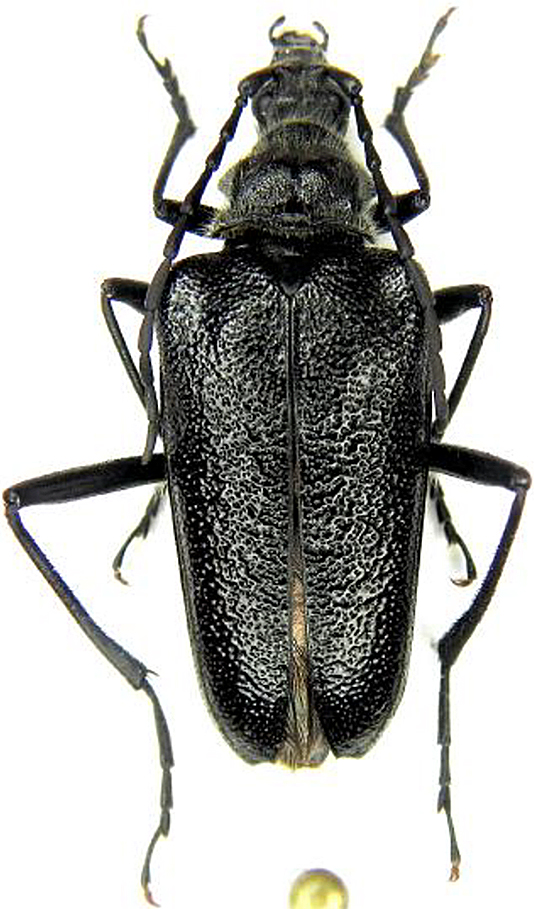| 466 _____________ Mun. Ent. Zool. Vol. 8, No. 1, January 2013___________ |
|---|
PACHYTA GORODINSKII N. SP. FROM WESTERN CHINA (QINGHAI) (COLEOPTERA: CERAMBYCIDAE)Pierpaolo Rapuzzi* |
| * Via Cialla, 48, I-33040 Prepotto (UD) ITALY. E-mail: info@ronchidicialla.it |
| [Rapuzzi, P. 2013. Pachyta gorodinskii n. sp. from Western China (Qinghai)(Coleoptera: Cerambycidae). Munis Entomology & Zoology, 8 (1): 466-467] |
| ABSTRACT: In this paper is described a new species of Pachyta Dejean, 1821 from China, Qinghai province. The new species is close to Pachyta lamed (Linnaeus, 1758). |
| KEY WORDS: Cerambycidae, Pachyta, new species, China. |
| Thanks to my friend Andre Gorodinski from Moskow (Russia) I had the opportunity to study several Cerambycidae collected in China. Among them I found a specimen belongs to the Genus Pachyta Dejean, 1821 but of an unknown species. The new species is close to Pachyta lamed (Linnaeus, 1758) but easy to be distinguish for the black color of the body, the deeper punctures on elytra and pronotum and the prominent antennal tubercles. |
| Pachyta gorodinskii n. sp. (Fig. 1) |
| Material examined: Holotypus female: China: Qinghai prov., Lajishan ridge, near Guide, 3300 m., 20.VII.2010, A. Gorodinski lgt. Holotypus in collection P. Rapuzzi. |
| Description of the Holotype: Length 20 mm, width 7 mm. Body entirely black. Head long, with dense, deep and rugulose punctures, denser on the vertex. Antennal tubercles prominent and acute. Front between eyes with a deep groove. All the head surface covered by long, thin, silvery erect hairs. Pronotum as long as wide, deep punctured. Sides with an obtuse tooth just up to the middle. Disk of pronotum with two large and flat callosities, the middle with a groove, more visible in the first half. Base of pronotum with a large transverse groove. Pronotum with dense, long, thin erect silvery hairs. Elytra long, convex, restricted towards apex. Shoulders obtuse, with a small groove between side and scutellum. Apex evidently convex truncate with a small acute tooth at the sutural side. Elytra shiny, with dense punctures, denser on the first third where is more or less rugulose; towards the apex it is more sparse but it still remains dense and deep. Elytra nearly glabrous except for very short and sparse erect silvery hairs. Scutellum triangular, long and matt due to a very dense and fine punctures. Legs very long and slender. Tibiae slightly curved, more pronounced on hind tibiae. Tarsi very long with the last joint very slender and long. Inner side of femora with a fringe of dense erect silvery hairs. Antennae slender, short, reaching the middle of elytra. Fourth joint shorter then third. Fifth joint longer than each other joint. Antennae glabrous, except for the first two joints that show very short brown setae. |
| Discussion: Genus Pachyta Dejean, 1821 was represented by 6 species in China (Loble & Smetana, 2010): P. bicuneata Motshulsky, 1860; P. degener Semenov & Plavilstshikov, 1936; P. felix Holzschuh, 2007; P. lamed (Linnaeus, 1758); P |
| _____________ Mun. Ent. Zool. Vol. 8, No. 1, January 2013___________ 467 |
| .mediofasciata Pic, 1936 and P. quadrimaculata (Linnaeus, 1758). The new species is closer with P. lamed and secondly with P. degener but it is easy to be distinguish from the first according the deeper punctures on the disk of pronotum, the stronger, denser and deeper punctures on the elytral surface. In P. gorodinskii n. sp. the antennal tubercles are acute and prominent, obtuse and short in P. lamed. The last tarsal joint is very slender and longer than in P. lamed. The erect hairs on pronotum and elytra are shorter, denser and light gold colored in P. lamed than in the new species. From P. degener it is distinguish because lacking the deep excavation at the side of the disk of pronotum and the elytral pattern. |
| Etymology: I dedicate the new species to my friend Andre Gorodinski from Moskow (Russia) as thanksgiving for the opportunity that he gives me to study such interesting Cerambycidae. |
| LITERATURE CITED |
| Gressitt, J. L. 1951. Longicorn beetles of China. Longicornia, II: 1-667. |
| Holzschuh, K. 2007. Beschreibung von 80 neuen Bockkafer aus der orientalischen und palaearktischen Region, vorwiegend aus Borneo und China (Coleoptera, Cerambycidae). Entomologica Basiliensia et Collectionis Frey, 29: 177-286. |
| Lobl, I. & Smetana, A. 2010: Catalogue of Paleartic Coleoptera. 6. Chrysomeloidea. Apollo Books, Stenstrup: 924 pp. |
| Podany, C. 1964. Monographie des Genus Pachyta Zett. (Col., Cerambycidae). Polskie Pismo Entomologiczne, XXXIV (4): 41-53. |
 |
| Figure 1. Pachyta gorodinskii n. sp. Holotypus. |
